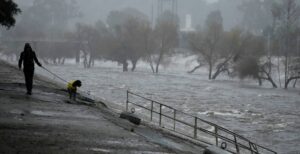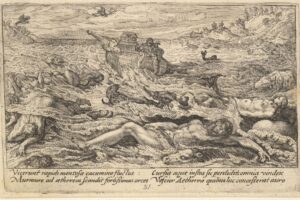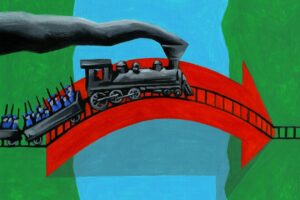Storms have long shaped human destiny, as Californians know all too well.
February 15, 2024
Given that much of California was suffering a severe drought just two years ago, it might seem ungrateful to complain about too much rain. Yet Californians have already managed two record-breaking storms this year, and more are expected. The increase in the frequency and strength of these weather events spells trouble for the state. Some worry it is a sign that the “Big One”—a massive once-in-a-millennium storm—is nigh.

A man walks his dog on the edge of the Los Angeles River, Feb. 4.
Scientists think that these storms are growing more severe as a result of climate change, but mythical stories about destructive floods have haunted humans for eons, from the Sumerian Epic of Gilgamesh in 2000 B.C. to the biblical story of Noah and his ark.
Thousands of years of accumulated climate records combined with modern computing methods have led to new insights for the role rain has played in shaping human destiny. For example, excessive rain can now be added to the list of reasons behind the collapse of the Roman Empire. Apparently the final decades of the fifth century were unusually wet. Harvests failed and granaries rotted, setting off a cataclysmic chain of famines, wars and mass migration that hastened the empire’s demise.
Abnormal rainfall needn’t spell human disaster. In the early 13th century, 15 consecutive years of unprecedented rainfall turned the barren Mongolian steppe into fertile grassland. The region could finally feed the massive armies that allowed Genghis Khan to pursue his dream of a Mongol empire. But the intensely wet spring of 1242 may have pushed his descendants to abruptly leave Central Europe. The Mongol cavalry could seemingly defeat any foe except the bottomless mud of the Hungarian plain.

A series of engravings made for the first edition of the ‘Liber Genesis,’ 1612
A recurring theme in most Great Flood myths is how destruction can be creative; the washing away of the past being necessary for a redemptive transformation. A real-life example can be seen in Europe’s response to the crisis of 1816—the so-called Year Without a VolSummer. The 1815 eruption of Mt. Tambora in Indonesia ejected a huge cloud of sulfate gases into the atmosphere and created an unseasonable chill in much of the Northern Hemisphere. Endless rain watered already sodden fields. Communities starved; typhus outbreaks infected millions of people; rioting became endemic.
The sheer scale of the human emergency forced a reconceptualization in Britain and elsewhere of the purpose of government. No longer could it be concerned only with taxes, laws and diplomacy. The modern state must also consider public health, public administration and public responsibility.
California’s Great Flood of 1862, which remains the state’s worst disaster, was another catalyst for change. The storm began in late 1861 and lasted eight weeks. California’s Central Valley became an inland sea. At least 4,000 people died and a quarter of the state’s economy was destroyed. The Sacramento government relocated to San Francisco, which was also partially underwater.
The robust reconstruction efforts afterward marked a shift in attitude. Californians erected new flood defenses and instituted better building regulations. Sacramento rose again, literally 10 feet higher than before. The infrastructure may be up to 150 years old, but it is still doing its job. No matter what the rain brings, the answer isn’t an ark. It is being prepared.






